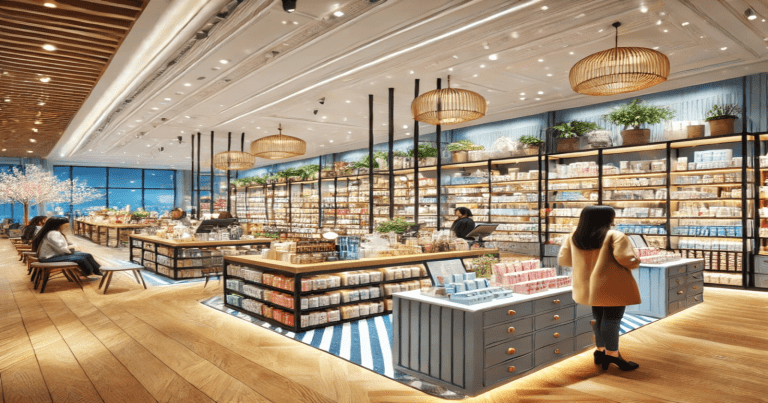Retail is the selling of goods and services to consumers. It’s the final step in the supply chain, connecting producers to consumers. Retail trade is selling goods or services to a consumer directly for his own use. To understand what is retail, one has to understand all possible avenues by which a company can retail goods to customers, like through stores, online media, and mobile services. Retail trade examples are grocery stores and clothing boutiques or, at the most extreme, Amazon, the online marketplace. It is the last interface in the supply chain, where the product gets delivered directly to the end-users. Retail trade connects the manufacturers and wholesalers with the consumer. This ensures that products can readily access customers and satisfy their wants and needs. Retail trade examples are 7-Eleven convenience stores, Walmart department stores, and Flipkart e-commerce sites. In addition to merchandising various products with personal services, retail trade provides many ways to purchase goods, thus considerably increasing customer satisfaction and catalysing economic growth. The article covers the various functions, classifications, and clear instances of retail trade in our day-to-day existence.
What is Retail Trade?
Retailing means selling a small quantity of either goods or services to the final consumer. In this sense, the industry includes road intermediates between manufacturers-wholesalers and single-buyer consumers, whether offline shops, which have existed for centuries or the rapidly growing mail order and web outlets.
It is an important sector of any economy. Retailing fulfils the needs and wants of consumers by selling goods on an everyday basis, small commodities, rather than in handfuls as compared to wholesalers, directly to the final consumer. Retailers facilitate the buying process by providing convenience, variety, and services catering to the customers.
Features of Retail Trade
Selling goods or services directly to customers is the focus of retail trade in minuscule quantities. It creates convenience, according to the vision of connecting manufacturers and end-users. Characteristics of retail trade are customer-oriented, small-scale operations, and product diversification.
- Minor Dimensions: Retailers sell products in small quantities to consumers.
- Direct Contact: The retailers communicate face-to-face to know what customers need.
- Variety of Products: The retailers stock various products to meet the varied tastes of the consumers.
- Customer Focus: The retailers focus on customer satisfaction and service.
Types of Retail Trade
The nature of retail trade changes depending on the consumer and business’s character. Retailing constitutes an extremely varied array of formats, contrasting with physical stores on one end and online space on the other. Each performs a specific task according to various circumstances in the processes of individual consumer behaviour in this economy. The main types of retail mainly include
Store-based Retailing
Store-based retailing means selling a good or service in physical outlets where the customer can browse and purchase in person. It may range from department stores to supermarkets, speciality shops, and convenience stores, thus meeting diverse consumer needs.
- Department Stores: Here, lots of different goods such as fashion, home goods, and electronics. For example, Macy’s and Target.
- Supermarkets: It deals only with food and other types of goods for home use. Example: Walmart and Kroger.
- Speciality Stores: A speciality store carries particular goods, clothing or electronics. Example: Nike stores and Apple stores.
- Convenience Stores: A convenience store is located in a residential area where daily necessities are sold. Example: 7-Eleven.
Non-store Retailing
Non-store retailing takes place outside of conventional stores and provides customers with many options and comforts. Non-store retailing includes e-commerce, direct selling, telemarketing, and vending machines catering to every possible modern approach to shopping.
- E-Commerce: Anytime from anywhere a customer can shop. For example, Amazon, and Flipkart.
- Telemarketing: Selling over the phone.
- Direct Selling: Selling a product directly to the customer with demonstrations. Examples: Avon, Tupperware.
| Retail Trade Type | Subcategories | Description | Examples |
| Store-Based Retailing | Department Stores | Large stores selling multiple product categories under one roof. | Macy’s, Nordstrom, Reliance Retail |
| Supermarkets | Self-service stores offer groceries, household items, and more. | Walmart, Kroger, Big Bazaar | |
| Specialty Stores | Stores focusing on a specific product category, such as electronics or fashion. | Apple Store, Sephora, Nike Outlets | |
| Convenience Stores | Small stores are open 24/7, selling daily essentials like snacks and beverages. | 7-Eleven, Local corner shops | |
| Discount Stores | Stores provide products at reduced prices, often in bulk. | Dollar Tree, Costco | |
| Non-Store Retailing | E-Commerce | Online platforms allow customers to purchase products via websites or apps. | Amazon, Flipkart, Alibaba |
| Direct Selling | Sales representatives sell products directly to consumers through demonstrations or networking. | Amway, Tupperware | |
| Telemarketing | Selling products and services via phone calls. | Bank services, subscription-based sales | |
| Automatic Vending | Machines dispense products such as snacks and beverages without human assistance. | Vending Machines |
Real Life Examples of Retail Trade Outlets
Numerous retail trade examples reveal this business’s broad range and scale. Retailers bring goods to customers at a place and in a time frame convenient for different needs. Such can be accomplished by establishing small retail outlets or larger department stores or through online services. These examples describe how retail brings manufacturers to consumers. Accessible retail points with a personal touch guarantee confidence in future purchases. Survey examples of retail trading outlets depicted below show the scope of this industry.
Grocery Stores
Grocery stores\ sell daily food products and household necessities to individual consumers. Local markets such as Trader Joe’s or Spar provide a short range of fresh fruits, snacks, and packaged groceries. Generally, that type of store has a section for the organic and speciality, which is commonly attractive to health-conscious buyers. Other stores combine online orders with delivery to the residence for easier reach of the consumers. A grocery shop is considered the neighbourhood bloodline as long as its staples are always stocked.
Fashion Garment Shops
Clothing boutiques like Zara and H&M offer trendy, inexpensive garments to various target groups. It has casual, formal, and seasonal collections in its stock. These boutiques tend to render stock updates from time to time so that they have the latest trends and demands from customers. Personalized assistance and one classy atmosphere make the experience enjoyable, encouraging loyalty among such customers. Many boutiques also have online platforms through which anyone worldwide can access their collections.
Marketplaces Online
Online marketplaces, such as Amazon and Flipkart, redefined shopping. The available products are vast in various categories. Because of the convenience of the shopping platform, consumers can shop from anywhere at any time. Through comparison of prices, reading reviews, and taking in discounts, online shopping is cost-effective and reliable. Advanced algorithms offer personalized recommendations that make the overall shopping experience even better. Logistics and delivery networks ensure timely and efficient orders to customers.
Pharmacies
Pharmacies like Walgreens offer prescription and over-the-counter drugs, ensuring all healthcare products are available. Modern pharmacies have provided other services, including health consultations, vaccination programs, and chronic disease. An informed pharmacist attends to the customers and gives advice and recommendations to meet their needs. Pharmacies play a great role during emergencies as they provide life-saving medications at large supply.
Convenience stores
Convenience stores bring together neighbourhoods such as 7-Eleven and Circle K and serve them in minutes when the shoppers run out of some everyday essentials. These stores tend to be open long hours with accessible locations where people live or congregate. It is stocked with snacks, drinks, toiletries, and many other consumer goods for immediate needs. Some convenience stores even provide gasoline, e-banking services such as ATMs, and ready-to-eat meals, broadening their utility. Their small size is offset by many products, making them a preferred place for short, hassle-free shopping.
Benefits of Retail Trade
Although products are easily accessible, they greatly enhance the shopping experience of both consumers and the economy. Some tailor-made services and different options are available to fit the unique needs of certain customers. Below are details on the expanded benefits of these retail trade examples:
Convenience
Retailers reduce the time spent shopping by placing products closer to consumers. For instance, neighbourhood grocery stores lessen the time and cost of transport for consumers. They even do home delivery and online shopping, enhancing accessibility even more. Also, a quick checkout process with multiple payment methods adds more taste to shopping. The retail price of the goods ensures availability at all times and meets relevant instant needs.
Diversity
Retailers would also provide various products at one stop, where customers could browse many options. Hence, the diversification would satisfy differences and budgets among their clients. All these are converged under a single shopping venue, which is why large department stores have apparel, electronics, and groceries. After adding local and international brands, they can satisfy most consumers.
Service Feature
Retailers emphasize a consumer’s shopping experience by offering services that are specific to the customer’s needs. The workers aid the customer in choosing the right products that are based on professional consultancy and recommendations. Other outlets award loyalty points, discounts, and promotions to habitual customers. Several retail stores also provide add-on services such as comfortable seating arrangements, free product samples, or trial rooms to attract a larger customer base. This kind of service ensures long-term customer relations and, thus, repeat business.
Accessibility
Retail trade makes goods widely available in both urban and rural settings. Convenience stores and internet portals transcend geographical barriers and reach even remote areas. Retailers for better customer communication, have equally adopted local languages and cultural practices. They make stores and special services accessible for physically impaired individuals. Accessibility brings inclusiveness in that all consumers would be able to access their requirements with ease.
Economic Development
It further develops the economy through employment creation and support for small businesses. These retail shops hire people to work in the various outlets, such as selling and warehousing and customers. Small-time retailers also sustain the local economies by buying some of their products from close small-scale suppliers..
What is Retail FAQs
1. What is Retail Management?
Retail management involves planning, organizing, and controlling the retail function to increase customer satisfaction and sales. It comprises inventory, supervision of employees, customer handling, and selling techniques.
2. What is Retail Trade?
A retail business directly sells goods and services to consumers for their use. It operates in physical stores, e-commerce sites, or direct selling methods.
3. What is Retail Banking?
Retail banking is the division of a bank that deals directly with individual customers, providing financial services such as savings accounts, loans, and credit cards. HDFC, SBI, Citibank, etc., provide these services.
4. What is APSBCL Retailer?
APSBCL retailers are those licensed retailers who sell liquor through the Andhra Pradesh State Beverages Corporation Limited.
5. What are Examples of Wholesale and Retail Trade?
Wholesalers are middlemen who sell to retailers in bulk, while retailers are sellers who sell directly to consumers. For instance, Walmart is a retail company, while Costco is a wholesaler.


